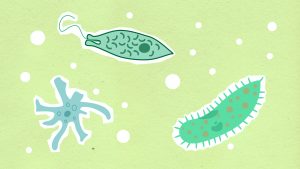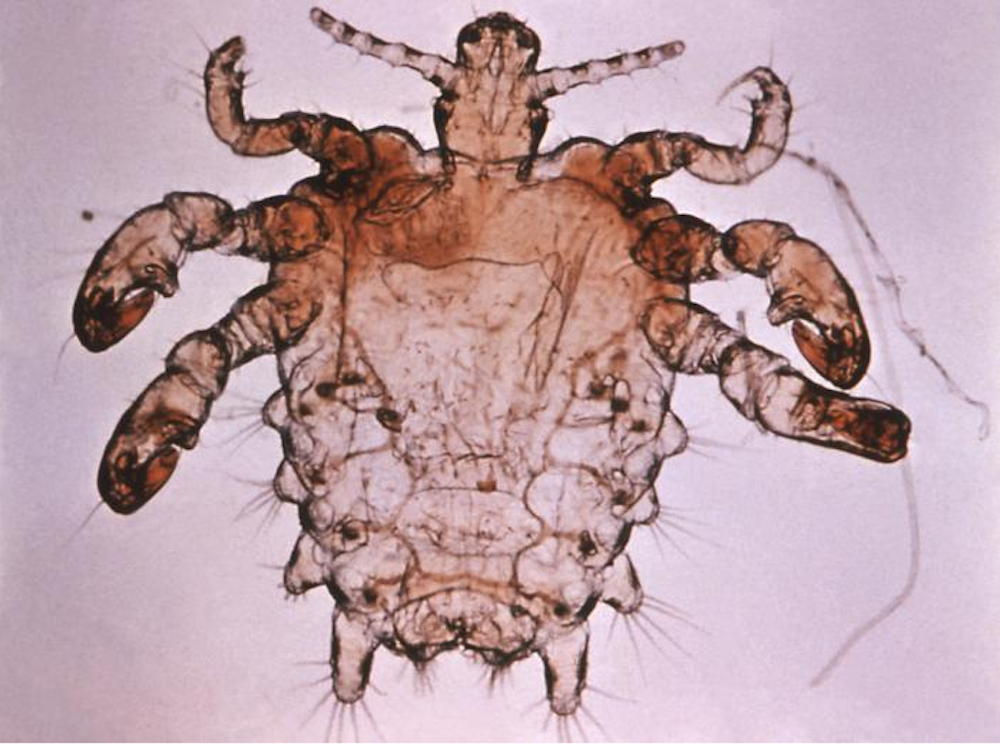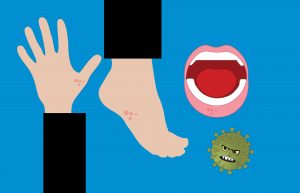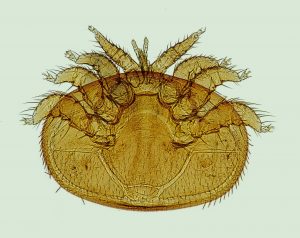
A parasitic infection is a disease that is transmitted by parasites. Parasites are microscopic organisms that live inside or on the exterior of a larger host, using the host as their food source.1 There are three types of parasites that target humans: protozoa, helminths, and ectoparasites. Protozoa are microscopic, one-celled organisms that can pass to humans through contaminated food or insect bites. Helminths are parasitic worms (e.g., the tapeworm) that can also cause infectious diseases in their hosts. Lastly, ectoparasites are parasites that live on the exterior of another organism, usually human skin. Ectoparasites may create colonies on the outer skin layer allowing them to multiply quickly in numbers and strength.2
Sexually Transmitted Parasitic Infections
The three parasitic infections that can be sexually transmitted are pubic lice, scabies and trichomoniasis.3
Pubic Lice

Pubic lice (often called “crabs”) are a parasitic insect most often found in a person’s pubic hair and spread through sexual contact. Pubic lice does not transmit diseases, however, the scratching of the skin may cause secondary bacterial infection.4 In the United States, an estimated 3 million of people are infected by this parasite. The main symptoms of pubic lice are is an intense itchiness in the genital region, a mild fever, and the presence of nits (small egg sacs) in the pubic hair.5 There are both over-the-counter and prescription drugs available for treatment. For more information regarding pubic lice, read this article.
Scabies

Scabies is a skin condition in which a parasite (also called a mite) burrows under a person’s skin causing irritation. While scabies can be spread through sexual contact, it can also spread through shared clothes, blankets, or towels. Since scabies are easier to spread than lice, it affects more people and has become a common condition worldwide. Symptoms of scabies often do not appear until 4 to 6 weeks after the initial infection and include an extremely itchy rash. A more severe version of scabies is crusted scabies (also called Norwegian Scabies) and typically occur, in people with weak immune systems.6 Prescription medication is necessary for treatment of scabies, so it is important to visit a doctor if a person believes they may be affected.7
Trichomoniasis
Trichomoniasis is a very common sexually transmitted parasitic infection. Many people infected with the infection will not experience symptoms. Symptoms in females typically include irritation or redness of their genitals, a thin discharge that may be clear, yellowish, or greenish, and pain while urinating. Symptoms in males often include irritation of the penis, discharge from the penis, and pain while urinating or ejaculating. A person suffering from this disease needs to see a doctor for treatment because the infection can persist for very long periods of time if left untreated.8 For more information on trichomoniasis, please read our article.
Other Parasitic Infections
In the United States

Parasitic infections in the United States are most common in southern areas with poor sanitation, poor housing, and in warm weather. Two common worm infections found in these areas are Toxocariasis and Cysticercosis.9 These infections are more commonly found in the Hispanic communities of these regions. These infections are spread often to people who interact with dirt frequently, like farmers, and can also be spread by contact with feces of some animals like dogs or pigs. While some people may not experience any symptoms, others may experience vision impairment, organ damage (such as a kidney or liver), or more serious symptoms such as seizures.10, 11 Anyone infected by these diseases should see a doctor for treatment. Two common protozoan infections in low income areas of the U.S. include Chagas disease and Toxoplasmosis.9 Both diseases are spread through parasites, and an infected person may present as asymptomatic (shows no symptoms). However, in some cases, these diseases may cause serious cardiac or intestinal problems. Treatment should be administered by a doctor. 12, 13
Around The World

Parasitic infections occur commonly around the world, and are especially prevalent in tropical and subtropical areas.1 Malaria is a common and dangerous infection in tropical areas, with estimates of 214 million cases in 2015. The disease is very prevalent in parts of Africa, and is spread by a certain type of mosquito. Malaria is a serious and sometimes fatal disease that initially causes flu-like symptoms and, if left untreated, can progress to more serious outcomes such as kidney failures, seizures, and death. If recognized and treated by a doctor, malaria can be cured; however, people in the areas mentioned above often do not have proper access to doctors and medication.14
Neglected Tropical Diseases (NTDs) are parasitic and bacterial infections that affect over 1 billion of people each year. Examples of these diseases include Schistosomiasis, Guinea Worm Disease, Lymphatic Filariasis.15 They are mostly found in mostly poverty stricken tropical areas of Africa, Asia, and Latin America. Typically, people living in these regions do not have access to proper sanitation or clean drinking water, and come in close contact to domestic animals and livestock.
Conclusion
Parasitic infections are common around the world, but they are the most dangerous and widespread in impoverished tropical areas. Some of the infections can be spread sexually, while others are spread through poor sanitation and living conditions. Most of the infections can be treated by a doctor, however, they often strike countries that are unable to provide proper medication and treatment.
References
- “Parasites.” Centers for Disease Control and Prevention. Centers for Disease Control and Prevention, 28 July 2016. Web. 24 Jan. 2017.
- “About Parasites.” Centers for Disease Control and Prevention. Centers for Disease Control and Prevention, 22 Apr. 2016. Web. 24 Jan. 2017.
- “STD List – Different Types of Parasitic STDs.”The STD Project. N.p., 08 Aug. 2015. Web. 24 Jan. 2017.
- “Treatment.” Centers for Disease Control and Prevention. Centers for Disease Control and Prevention, 17 Aug. 2015. Web. 24 Jan. 2017.
- “Pubic Lice | Crabs STD | Symptoms, Testing and Treatment.” Planned Parenthood N.p., 01 Nov. 2016. Web. 24 Jan. 2017.
- “Scabies.” Scabies | American Academy of Dermatology. N.p., n.d. Web. 24 Jan. 2017.
- “Scabies.” Centers for Disease Control and Prevention. Centers for Disease Control and Prevention, 02 Nov. 2010. Web. 24 Jan. 2017.
- “Trichomoniasis – CDC Fact Sheet.” Centers for Disease Control and Prevention. Centers for Disease Control and Prevention, 18 Oct. 2016. Web. 24 Jan. 2017.
- Hotez, Peter J. “Neglected Parasitic Infections And Poverty In The United States.” Plos Neglected Tropical Diseases 8.9 (2014): 1-5. Academic Search Complete. Web. 24 Jan. 2017.
- “Toxocariasis FAQs.” Centers for Disease Control and Prevention. Centers for Disease Control and Prevention, 10 Jan. 2013. Web. 24 Jan. 2017.
- “Parasites – Cysticercosis.” Centers for Disease Control and Prevention. Centers for Disease Control and Prevention, 16 Apr. 2014. Web. 24 Jan. 2017.
- “Toxoplasmosis.” Mayo Clinic. N.p., n.d. Web. 24 Jan. 2017.
- “Detailed FAQs.” Centers for Disease Control and Prevention. Centers for Disease Control and Prevention, 19 July 2013. Web. 24 Jan. 2017
- “Malaria.” Centers for Disease Control and Prevention. Centers for Disease Control and Prevention, 20 Dec. 2016. Web. 24 Jan. 2017.
- “Neglected Tropical Diseases.” World Health Organization. N.p., n.d. Web. 24 Jan. 2017.
Last Updated: 07 February 2017.
